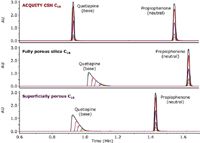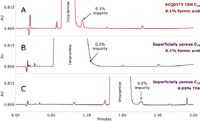Improving Mass Load Capacity for Basic Compounds Using Charged Surface Hybrid (CSH) Technology Columns
Waters Application Note
Kenneth J. Fountain and Hillary B. Hewitson, Waters Corporation, Milford, Massachusetts, USA.
Introduction
Many modern stationary phases suffer from poor chromatographic performance for basic compounds at low pH, especially when using low-ionic strength mobile phases such as formic acid. While the exact cause for this behavior is not completely known, it is thought that variations in the surface charge of high purity chromatographic materials can have a large impact on the chromatography, even at fairly low analytical loads. The advantages of using Charged Surface Hybrid (CSH) technology columns for impurity profiling in stability indicating methods and/or forced degradation studies of commercial drug substances will be demonstrated using typical LC–MS conditions.
Experimental
UPLC System: Waters ACQUITY UPLC H-Class system with a PDA detector and an SQ mass detector
Columns: Waters ACQUITY UPLC CSH C18, 2.1 × 50 mm, 1.7 µm
Fully porous silica C18, 2.1 × 50 mm, 1.8 µm
Superficially porous C18, 2.1 × 50 mm, 1.7 µm
Flow-rate: 0.6 mL/min
Detection: 254 nm
All other conditions are specified in figure captions.
Results and Discussion
In order to compare the loadability of different stationary phases at low pH, a mixture of a neutral and a basic compound were analysed at different mass loads on an ACQUITY CSH C18 column, a fully porous silica C18 column and a superficially porous C18 column using formic acid mobile phases (Figure 1). As the mass load increases for the neutral compound (propiophenone), all three columns exhibit symmetrical peak shape and no mass overloading is observed. However, when the mass load of quetiapine (a weak base) is increased on the three columns, differences in performance can be observed. The fully porous silica C18 and superficially porous C18 columns quickly become overloaded under the same gradient conditions for this compound. This occurs with a mass load as low as 50 ng on-column (20 µg/mL). The ACQUITY CSH C18 column, however, does not show mass overload for any of the concentrations of quetiapine, indicating that the performance of this column is identical for all analytes including basic compounds, especially in low-ionic strength conditions.

Figure 1: Loading capacity for quetiapine (base) and propiophenone (neutral) on three different columns in formic acid conditions. Mixtures containing 2â200 µg/mL each of quetiapine and propiophenone were prepared in 50/50 CH3CN/H2O. Mobile phase A was 0.1% formic acid in water, and mobile phase B was 100% acetonitrile. The gradient was from 5 to 95 %B in 2.5 minutes. Injection volume was 5 µL. Column temperature was 30 °C.
The ability to load large amounts of basic compounds in low-ionic strength mobile phases has many practical implications, especially for impurity profiling and identifying unknown impurities in stability indicating methods and/or forced degradation studies using LC–MS. For this type of work, a large amount of the active pharmaceutical ingredient (API) must be injected in order to see low-level impurities in the baseline. To demonstrate this, a 0.5 mg/mL solution of imipramine spiked with 0.1% of amitriptyline was injected onto ACQUITY CSH C18 and superficially porous C18 columns using formic acid mobile phases (Figure 2). Since amitriptyline elutes on the tail end of the imipramine peak, this example represents the challenges faced by LC–MS scientists who are routinely trying to identify unknown low-level impurities in a new synthesis pathway or forced degradation sample. Since the imipramine is massively overloaded on the superficially porous C18 column, the ability to see the 0.1% impurity on the tail is lost with formic acid [Figure 2(b)]. Resolution can be improved on this column by substituting formic acid with TFA [Figure 2(c)]. However, when trying to get mass spectral information on unknown impurities in the baseline, TFA is not a desirable mobile phase additive, since it severely suppresses ionization. In the case of the superficially porous C18 column, the impurity peak cannot be seen in the total ion chromatogram, and thus, no molecular weight information can be obtained [Figure 3(b)]. Since the imipramine peak is not heavily overloaded on the ACQUITY CSH C18 column under formic acid conditions [Figure 2(a)], one can obtain both full resolution of the impurity and molecular weight information in the same run [Figure 3(a)].

Figure 2: UV chromatograms for the analysis of trace impurities on ACQUITY CSH C18 and superficially porous C18 columns. Mobile phase A was water, mobile phase B was 100% acetonitrile, mobile phase C was 2% formic acid in water, and mobile phase D was 2% TFA in water. The gradient was from 25 to 35 %B in 2 minutes, followed by an increase to 95%B in 1 min. Different percentages of mobile phase C and D were programmed to get the concentration of acidic modifier shown. Injection volume was 5 µL. Column temperature was 40 °C.
Conclusions
CSH Technology columns have excellent loadability for basic compounds, and can be routinely used in LC–MS applications where low-ionic strength mobile phases (e.g., formic acid) are typically used. This allows separations of basic compounds to be performed at high mass loads without the need for ion-pairing agents such as TFA to improve peak shape, which is useful for applications where low-level baseline impurities must be detected in the presence of a large amount of API.

Figure 3: Total ion chromatograms (TICs) for the trace impurity analysis shown in Figure 2.

Waters Corporation
34 Maple Street, Milford, Massachusetts 01757, USA
tel. +1 508 478 2000 fax +1 508 478 1990
Website: www.waters.com

Separating Impurities from Oligonucleotides Using Supercritical Fluid Chromatography
February 21st 2025Supercritical fluid chromatography (SFC) has been optimized for the analysis of 5-, 10-, 15-, and 18-mer oligonucleotides (ONs) and evaluated for its effectiveness in separating impurities from ONs.



















